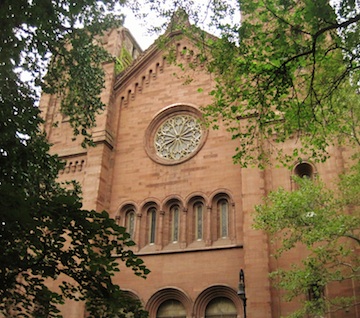Historic Chapel of St. George Turns 200
The tall, red church building on the east edge of Greenwich Village is not just an old sanctuary for solemn hymns and whispered prayers. From an assassination attempt to a controversial costume party, several intriguing events color the history of the Chapel of St. George. The church’s 200-year anniversary is the perfect excuse to dig into its past. Initially located in lower Manhattan, the Chapel of St. George became the official meeting place for its New York congregation in 1811. Two centuries later, St. George’s has since moved to its current building in Stuyvesant Square – a lofty brick chapel erected in 1846. The building’s two architects, Otto Blesch and Leopold Eiditt, designed it using the Romanesque Revival style that was popular in early America.
Initially located in lower Manhattan, the Chapel of St. George became the official meeting place for its New York congregation in 1811. Two centuries later, St. George’s has since moved to its current building in Stuyvesant Square – a lofty brick chapel erected in 1846. The building’s two architects, Otto Blesch and Leopold Eiditt, designed it using the Romanesque Revival style that was popular in early America.
A fire burned St. George’s barely 20 years after its completion, leaving only the walls and part of the roof undamaged. Nevertheless, the restored chapel replicated the original design exactly.
The assassination attempt in St. George’s went grossly awry. Philanthropist and industrialist J.P. Morgan attended the Chapel of St. George for several years with his son, J.P. Morgan, Jr. Despite Morgan’s famous generosity, he had enemies; anarchists hated him simply for his industrialism. One day in St. George’s, while Morgan and his son sat listening to the Reverend, an assassin aimed a gun at Morgan, Jr. and fired. He missed. He fired again, this time hitting a doctor who was volunteering as an usher. The Reverend immediately ordered the organist to begin playing the National Anthem, and everyone stood and sang along in attempt to prevent the shooter from causing further harm. Morgan and his son were safe, but unfortunately the doctor died from the wound. The assassin’s first shot left a bullet hole in the wall that remains to this day.
In 1897, Rev. William Rainsford refused to confirm or deny whether he had advised the parishioners not to attend the Bradley-Martin costume ball which was to be held at St. George’s. What he “may have advised them” was “nobody’s business” but his and theirs. Various publications quoted Rainsford as saying that the ball was nothing but an extravagant display of wealth, and reporters probed him to see if he also objected to the accumulation of wealth in general. Rainsford replied that he wanted to preserve New York City against accusations of ostentatiousness. The ball occurred in February, and promoters hoped it would “eclipse anything of the kind in the history of the city.” In any case, the affair stirred up some disagreements within both the clergy and the congregation of St. George’s.
Today, however, the 200th anniversary commemorates more than a building with a long and varied history. St. George’s also celebrates the service of its congregation, which maintains several ministries, including the first soup kitchen in New York City. Check out volunteering opportunities at www.calvarystgeorges.org.
